Top News

July 9, 2015 Ryukyu Shimpo
The Japan Traditional Cultures Foundation held its 19th award ceremony at Mitsukoshi Theater in the Chuo district of Tokyo on July 7. Thirty-five-year old Ryukyu dance grand master Yoshikazu Sanabe from Ryukyu Buyo Seibukai received the award. The award is given to one practitioner of traditional arts every year to encourage their future contribution to the field. Sanabe became the first awardee from Okinawa.
Hideki Tanaka from the selection committee explained his selection; “Sanabe was valued as an up-and-coming dancer with fresh expressions and a sense of presence. As he also works on Kumiodori, his techniques are expected to develop as one of the best young female impersonators. All the committee members shared big expectations for him.”
“Uchinanchu have been embracing uta-sanshin through a range of severe situations during the 70 years after the war. I would like to devote my work to the protection, inheritance and growth of Okinawan traditional arts, in valuing Okinawans’ Chimugukuru or compassionate hearts, and I see this award as an encouragement.” Sanabe stated.
The foundation will hold a commemorative dance show by Sanabe from 1p.m. on July 20 at the National Theatre Okinawa in Urasoe.
(English translation by T&CT and Sayaka Sakuma)
Go to Japanese

July 13, 2015 Yoshiharu Higa, Correspondent of Ryukyu Shimpo
In a gentle rain in the morning of June 30, a protest rally against the construction of a new offshore U.S. air base in Henoko was held at Union Square Park in New York. In the lead up to Okinawa Memorial Day, participants carrying placards saying, “No Henoko base” gathered at the park. Rachel Clark, who led a grassroots effort in the suburbs of New York to protest against the plan to move U.S. Marine Corps Air Station Futenma to the Henoko district in Nago, organized the rally. The participants mainly consisted of young people.
Rallies and performances by artists are held in the park every day. The park is historically known as a place where citizens gather to preserve freedom of speech and expression. At the rally site, the organizers displayed many photographs of the beautiful Henoko sea, attracting many visitors.
As well as New Yorkers, tourists and international students from other countries stopped by the rally.
The event organizers explained the current situation in Okinawa and expressed opposition to the new base’s construction in Henoko. Some who stopped at the rally passionately asked questions.
Many people acknowledged what has been happening in Okinawa. The visitors signed a petition demanding cancellation of the Henoko relocation plan.
Clark stressed the importance of the grassroots campaign.
(English translation by T&CT)
Go to Japanese

July 13, 2015 Ryukyu Shimpo
On July 13, the Okinawa Prefectural Assembly passed an ordinance to regulate the use of sediment such as soil and stone from outside the prefecture passed in a majority. The ordinance was proposed by the ruling parties. Members of the ruling parties and the New Komeito favored it, while members of the opposition, made up of the Liberal-Democratic Party and Japan Innovation Party, disagreed with it.
The ordinance will be enforced from November 1. It will affect the use of sediment for landfill for construction projects, including the construction of a new U.S. base at Henoko, Nago, which is part of a replacement of U.S. Marine Corps Air Station Futenma in Ginowan.
In debate prior to the vote, members of the ruling and opposition parties expressed opinion on whether to favor or oppose the ordinance.
Kazuo Okuhira (Kenmin Net) stated in favor of it: “It is necessary to take various measures to preserve biological diversity. This regulation is an effective measure to block invasive alien species. It is enacted based on the invasive alien species act.”
Dai Shimabukuro (LDP) expressed the opposite opinion: “It has a political objective to block the building work for the new U.S. base. It is not for the purpose of preserving the nature of Okinawa. Only two days have been given for deliberation. We have not heard opinion from municipalities and citizens.” He claimed that this should have been treated as a matter for extended deliberation.
(English translation by T&CT)
Go to Japanese
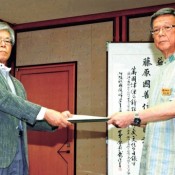
July 17, 2015 Ryukyu Shimpo
On July 16, Hiroshi Oshiro, chairman of an advisory panel to Okinawa Governor Takeshi Onaga charged with investigating his predecessor’s approval of a landfill in Henoko, Nago to build a new base as part of the relocation of U.S. Marine Corps Air Station Futenma, submitted the panel’s final report to the governor. The report concluded the panel had found legal flaws in the approval of the landfill.
Governor Onaga said, “I will treat the report with utmost respect in deciding how to respond to it.” He is likely to cancel the approval of the landfill in September after completing the necessary procedures, including a hearing from the Okinawa Defense Bureau.
After receiving the report, Onaga told reporters, “I will review contents of the report and listen to the opinions of the prefectural government’s legal advisers. I want to carefully discuss ways to respond effectively, including possible revocation of approval.”
Asked when he will make his decision, he replied, “I cannot say precisely when I will decide, because we are facing a critical moment in which the construction is entering the next stage.”
The report concluded that legal flaws exist in the former governor’s approval of Henoko landfill because it did not meet the requirements of the Public Water Body Reclamation Act that calls for appropriate and rational use of national land. The report specifically said that (1) there was a lack of examination as to the necessity of the landfill, because the previous governor determined that the landfill in Henoko was necessary simply based on the need to relocate the Futenma base; (2) when the advantages and disadvantages of the landfill plan are weighed against each other, it is not found to be a rational plan; (3) environmental conservation measures are not sufficient and do not respond to the previous governor’s written statement of opinion; (4) the landfill authorization is likely to have violated the Okinawa Biodiversity Strategy drawn up by the Okinawa Prefectural Government.
According to officials, the report stated that the necessity of the landfill has not been definitively established, referring to former Defense Minister Satoshi Morimoto’s remarks that the base does not necessarily need to be placed in Okinawa from a military standpoint, but that Okinawa is the best place to maintain the base when political considerations are taken into account.
The report also pointed out that the Henoko landfill violates the Ryukyu Islands’ Coastal Protection Basic Plan enacted by the Okinawa Prefectural Government in 2003. The planned landfill area in Henoko includes an area of the coast in which it is designated that no type of structure should built.
(English translation by T&CT and Sandi Aritza)
Go to Japanese

July 7, 2015 Ryukyu Shimpo
A group of young entrepreneurs is trying to name an alley at the foot of the Saion Bridge over Naha’s Asato River “Saion Street” in a bid to turn the area into a hub for new fashion.
The group includes Dan Shinjo, producer of “Plant & Soil,” a store that opened in 2014 selling cutting-edge fashion and household goods from Japan and abroad. Shinjo plans to work with neighboring “II3 (Uno Dos Tres),” an apparel store, and “13 (Trece),” a cafe, to provide a “playground without genre boundaries” that he hopes will revitalize the neighborhood.

Tomoya Miyagi (from left), Yoshihiro Miyagi and Oshiro of "II3" and "13" in Asato, Naha.
Shinjo, a graduate of Naha High School, worked for a fashion-related PR company after graduating from a university in Tokyo. He met with Tomoya Miyagi, who was working in the apparel industry in Tokyo, and they shared a vision for boosting Okinawa’s economy through fashion. Shinjo returned to Okinawa ahead of Miyagi and opened “Plant & Soil” with his high school classmate Shion Matsumora.
The three stores offer brand-name clothing items well known in Tokyo as well as Okinawa’s traditional crafts, such as Ryukyu glass mugs. They set up a coffee counter offering “Nago Coffee,” which is entirely produced in Okinawa.
U.S. brand fashion items and skateboards are available at “II3,” which opened July 4 and is run jointly by Miyagi and Kota Oshiro. The adjacent “13” is operated by Yoshihiro Miyagi, serving jerk chicken and alcoholic beverages.
The five plan to organize arts events and other joint activities at the three outlets. They want to create a place where both locals and tourists can gather. More information on the three stores can be found on Facebook.
(Translation by T&CT and Scott Murphy)
Go to Japanese

July 6, 2015 Hanae Higa Gushiken, Correspondent of Ryukyu Shimpo
On June 23, a memorial ceremony, by the Japanese title of “Irei no Hi,” was held in the garden of the Hawaii Okinawa Center in memory of all the lives lost in the Battle of Okinawa. The memorial was for all victims, regardless of nationality or allegiance during the war. More than 100 people attended, including members of the Hawaii United Okinawa Association (HUOA). At the ceremony, four Battle of Okinawa survivors, Takejiro Higa, Shinei Gima, Yoshinobu Oshiro, and Shinsuke Uehara spoke about their memories of the war.
In his opening remarks at the ceremony, Mark Higa, president of HUOA, said, “This year marks 70 years since the end of the war. It is very important for us to gather together, as we have today, to remember those lost in war.”
Takejiro Higa, who immigrated to Hawaii in his youth and later served as a U.S. military interpreter during the Battle of Okinawa, said, “When American troops handed me a picture that showed Naha burned to the ground, I was shocked. I learned that the U.S. military had mistaken traditional Okinawan turtle shell tombs for military facilities and were attacking them. I immediately explained the turtle shell tombs to them and made them stop the attacks.”
Shinsuke Uehara, who experienced the Battle of Okinawa at the age of twelve and is now a pastor in Hawaii, recalled his experience, saying, “A woman who called herself a nurse told everyone, ‘I’ve got poison, so everyone who wants some, come line up.’ Everyone wanted poison, but there was only a limited amount. Many people lined up, including me. I was praying that I would get some. But the poison ran out right before it was my turn, and I wasn’t able to get any.” He ended by saying, “Sometimes, it’s better when life doesn’t go the way you want it to.” Audience members nodded at his words.
As the sun was setting, attendees faced west, in the direction of Okinawa, and joined in a moment of silent prayer. The ceremony closed with a heartfelt sanshin performance by Derek Shiroma.
(Translation by T&CT and Sandi Aritza)
Go to Japanese
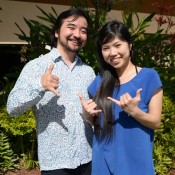
July 10, 2015 Sadaharu Shimabukuro of Ryukyu Shimpo
From July 10 to 12 on the island of Oahu, Hawaii, the 30th-anniversary of a sister-state affiliation between the State of Hawaii and Okinawa Prefecture was celebrated. Hawaii United Okinawa Association (HUOA), which consists of about 40,000 members, was the host for the delegation from Okinawa and the main organizer of anniversary events. The 2015 HUOA President is third generation Okinawan Mark Hideyuki Higa. He and his wife from Naha City, Hanae, were busy with preparation for the events.
Higa’s father’s side of the family is from Nago City, and his mother is from Naha City. When Higa’s father, who is second-generation Okinawan from Hawaii, was working on one of the U.S. military bases in Okinawa, he met Higa’s mother. He was born in Okinawa and has been going back and forth between Okinawa and Hawaii since his childhood. He has a jointly-run architecture business in Honolulu. His wife Hanae is a first-class architect. When she visited Hawaii eleven years ago, she met Higa.
Finding more opportunities to visit Okinawa since becoming president of the HUOA, Higa feels the connection between Okinawa and Hawaii when he returns home, receiving a warm welcome every time. When she moved to Hawaii, Hanae perpetuated Okinawan culture, sharing it with the Okinawan community living there.
HUOA presidents typically do one year of service. Higa and Hanae highlighted the word “Sumiti” (meaning ‘imprint’) from the lyrics of Tinsagu nu hana. They said that their ancestors “imprinted” wonderful culture on them. They said that this year, their goal was to think about what to do “for the next generation” and act on their ideas.
(English translation by T&CT and Megumi Chibana)
Go to Japanese
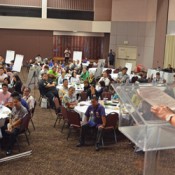
July 12, 2015 Shoichiro Yonamine of Ryukyu Shimpo
In the afternoon of July 11, the Hawaii United Okinawa Association (HUOA) and the Ryukyu Shimpo co-hosted a forum called “Connection Ichimadin (Forever): Future for Hawaii and Okinawa” at the Hawaii Okinawa Center. About 230 people from Okinawa and Hawaii took part. The participants were broken up into 18 round tables. They discussed ways to strengthen Uchinachu identity and preserve Okinawan traditional cultures through education. Okinawan Governor Takeshi Onaga and Hawaiian State Governor David Ige attended the forum and delivered their speeches. Onaga said, “I would like to study how the University of Hawaii was able to resuscitate Hawaiian language, and consider how we can apply this to our approach to resuscitating Ryukyuan languages.” Onaga expressed his idea of developing a strategy, based on the University of Hawaii’s approach, for preserving Ryukyuan languages, within a year.
Prior to the forum, a ceremony to mark the 25th anniversary of the establishment of the HUOA’s operating base, the Hawaii Okinawa Center, was held on the same day.
A Shinto ceremony was held at the “Hawaii Okinawa Plaza” to purify the building site ahead of construction of the commercial facility. The building project is aimed at raising funds for the Hawaii Okinawa Center. Those involved celebrated the construction.
(English translation by T&CT)
Go to Japanese
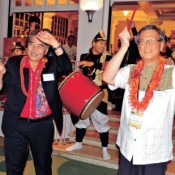
July 12, 2015 Shoichiro Yonamine of Ryukyu Shimpo reports from Honolulu
Okinawa Governor Takeshi Onaga attended a dinner held at the Hawaii governor’s official residence to celebrate the 30th anniversary of sister-state relations in the evening of July 10.
Hawaii Governor David Ige, a third-generation Japanese-American of Okinawan decent, called for further exchange between people in the two states. He said, “As a governor of Okinawan decent, I want friendly relations to continue in the future.”
Onaga invited the Hawaii Governor to attend a ceremony for the 30th anniversary of the establishment of a sister-state relationship between Okinawa and Hawaii, scheduled to be held in Okinawa in October.
Prior to the celebration dinner, the governors signed an updated memorandum of understanding on cooperation for clean energy.
After the dinner, Onaga remarked; “In the context of Hawaii, I would like to consider setting up something positive–an organization based on the spirit of “Bankoku Shinryo” (a bridge between nations).” He showed an eagerness to set up an institution in Okinawa for exchange and research in the Pacific Ocean region.
On July 11, other Hawaii-related events were held, including a groundbreaking ceremony for the Hawaii Okinawa Plaza and a forum by the Ryukyu Shimpo were held.
The state government and the Hawaii Okinawa Federation hosted the anniversary celebration dinner, in which guests from Okinawa, the Okinawa Hawaii Association and private companies were invited. Former Hawaii governor George Ariyoshi, who signed the agreement on the sister state affiliation between Hawaii and Okinawa 30 years ago was also invited to the dinner.
Onaga stated; “Okinawa and Hawaii have accumulated a history of exchange and friendship for more than 100 years, following the immigration of Okinawans to Hawaii in 1899. We are proud that many people from Okinawa have been very active and successful in Hawaii. I would like to express my heartfelt thanks to the state government and people of Hawaii who have supported and encouraged the immigrants from Okinawa.” He vowed to strengthen ties with Hawaii and keep them strong for the next generations.
The two governors updated the five-year clean energy cooperation agreement between Hawaii and Okinawa, which was signed in 2010, for the next five years. Four organizations, including Okinawa Prefectural Government, Hawaii State Government, the Ministry of Economy, Trade and Industry of Japan and the U.S. Department of Energy, will continue to work on joint research and development of new energy based in Okinawa and Hawaii.
The Hawaii Government has enacted legislation to switch all fossil fuels to renewable energy by 2045. Ige said, “The two regions have many similarities; they consist of islands and have a high dependence on fossil fuels. The joint project will help to produce a lot of good effects.”
(English translation by T&CT)
Go to Japanese
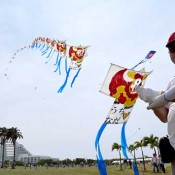
June 29, 2015 Ryukyu Shimpo
On June 28, the Wakanatsu National Kite Festival in Ishigaki was held at the Intercontinental ANA Ishigaki Resort Maesato Golf Course for the first time in Okinawa. Three hundred kites, from all over Japan and in all different shapes and sizes, were displayed in the event.
According to the Yaeyama Kite Armature Association, kites came from China in the 1700s during the Ryukyu kingdom. Some say it came from Satsuma. Kites spread nationwide during the Meiji period. Ishigaki is an area where kiting is popular and it has held the kite festival every year since 1971.
Harufumi Kinjo, chairperson of the Yaeyama Kite Armature Association, said, “Because we live in peace, we can enjoy kites. I am glad we could hold the festival.”
(English translation by T&CT, Hitomi Shinzato)
Go to Japanese

July 7, 2015 Ryukyu Shimpo
On July 7, a sit-in protest in front of the gate of Camp Schwab has reached one year since the start of action to block construction of a new U.S. base at Henoko, Nago. The governments of the United States and Japan plan to build an air-field to replace U.S. Marine Corp Air Station Futenma.
In the morning of July 6, in front of the gate of Camp Schwab, more than 150 people took part in the sit in protest. They were from both Okinawa and outside of the prefecture.
Takako Miyagi, 52, a resident of Tomigusuku, visited the sit-in front of the gate for the first time in a year. He said, “I feel the movement against new base construction has progressed and become more popular compared with one year ago. It is important to visit the scene. We have to try hard now for future generations.”
Tozo Matsumoto, 81, an Urasoe resident and a former public officer who had carried out a survey regarding land for U.S. military use, said, “It is regional discrimination to force placing an excessive burden of U.S. military bases in a certain part of the country.” He said, raising his voice, “The sit-in protest has marked one year, but now we will face a critical stage for our struggle.”
Atsuko Arai, 54, from Kanagawa Prefecture, took part in the sit-in for the first time. She said, “It is frustrating because the Henoko issue is still not resolved. But, we cannot give up. We would like to convey the situation to the people of Kanagawa.”
(English translation by T&CT)
Go to Japanese












 Webcam(Kokusai Street)
Webcam(Kokusai Street)


